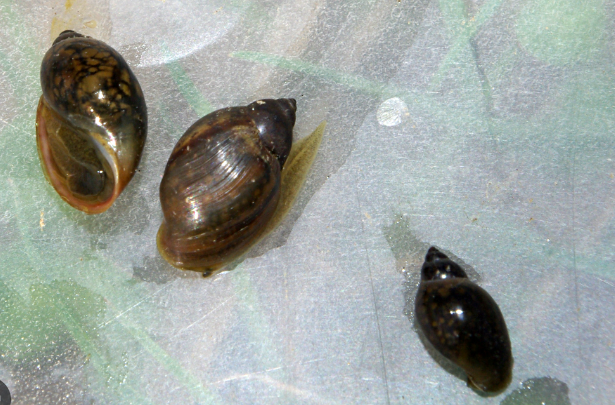
Aquarium enthusiasts often encounter a love-hate relationship with snails in their tanks.
While some may view them as pests, others recognize the valuable contributions these tiny creatures can make to the overall health and balance of an aquarium ecosystem.
In this guide, we’ll shed light on the often-overlooked benefits of bladder snails (Physidae) in your aquarium.
Introduction: The Unseen Allies of Your Aquarium
Bladder snails, often dismissed as common pests, are a species of freshwater snails known for their distinct bladder-like shells.
While they may reproduce prolifically under certain conditions, understanding and appreciating their positive attributes can transform the perception of these small, unassuming creatures.
1. Natural Detritus Managers: Aiding in Tank Cleanliness
One of the primary benefits of bladder snails lies in their role as efficient detritus managers. Detritus, comprising leftover food, plant matter, and other organic debris, tends to accumulate in aquarium substrates.
Bladder snails actively forage for detritus, helping to keep the substrate clean and preventing the build-up of decomposing organic matter.
By consuming detritus, bladder snails contribute to a healthier and more balanced aquarium environment. The reduction of organic waste minimizes the risk of ammonia spikes and enhances water quality, creating a more hospitable space for your aquatic inhabitants.
2. Algae Control: Nature’s Tiny Clean-up Crew
Bladder snails are voracious algae eaters, making them an excellent addition to aquariums struggling with algae issues. These snails actively graze on various types of algae, including green algae and diatoms, helping to naturally control and manage algae growth. Unlike some fish species that may be selective in their algae consumption, bladder snails are thorough in their efforts, leaving behind cleaner aquarium surfaces.
Their algae-eating behavior benefits not only the aesthetics of the tank but also contributes to the overall ecological balance. Bladder snails play a crucial role in maintaining a harmonious relationship between plants, algae, and other tank inhabitants.
3. Substrate Aeration: Enhancing Oxygen Levels
The burrowing behavior of bladder snails serves a dual purpose in the aquarium ecosystem. As these snails move through the substrate, they create channels that promote better water circulation and oxygenation.
By aerating the substrate, bladder snails help prevent compaction, creating an environment conducive to the growth of beneficial bacteria involved in the nitrogen cycle.
Improved substrate aeration supports the health of your aquarium’s microbial community, facilitating the conversion of ammonia to nitrite and nitrate. This, in turn, contributes to a more stable and biologically active aquatic environment.
4. Nutrient Cycling: Recycling Essential Elements
Bladder snails actively participate in nutrient cycling within the aquarium ecosystem. As they consume organic matter and produce waste, they release essential nutrients back into the water.

This natural recycling process benefits live plants in the tank, providing them with a continuous source of nutrients necessary for growth and development.
In planted aquariums, the presence of bladder snails can be particularly advantageous. The nutrients released by these snails contribute to a balanced and self-sustaining ecosystem, reducing the reliance on artificial fertilizers and promoting a more naturalistic approach to aquarium maintenance.
5. Indicator of Water Quality: Early Warning System
Bladder snails can serve as an early warning system for changes in water quality.
Being sensitive to fluctuations in parameters such as pH, ammonia, and nitrite levels, these snails may exhibit changes in behavior or reproductive patterns in response to deteriorating water conditions.
Observing the behavior of bladder snails can alert aquarium enthusiasts to potential issues, prompting timely intervention to address water quality concerns. This sensitivity makes them valuable indicators and a living barometer for the overall health of the aquarium.
6. Educational Value: A Window into Aquatic Ecosystems
The presence of bladder snails offers an opportunity for aquarium enthusiasts to explore and understand the intricacies of aquatic ecosystems.
Their lifecycle, behaviors, and interactions with other tank inhabitants provide a firsthand glimpse into the complexities of a thriving underwater world.
For educators and hobbyists alike, bladder snails can be an invaluable educational tool. Watching these snails navigate their environment, reproduce, and contribute to the ecosystem fosters a deeper appreciation for the delicate balance that exists within a well-maintained aquarium.
7. Food Source for Tank Inhabitants: A Natural Snack Option
In addition to their detritivore and algae-eating roles, bladder snails can serve as a supplementary food source for certain aquarium inhabitants.
Many fish species, such as loaches and pufferfish, relish the opportunity to consume small snails. By allowing bladder snails to coexist in your tank, you provide a natural and nutritious food option for these predator species.
This predation helps regulate the population of bladder snails and adds a layer of natural behavior to the aquarium.
However, it’s essential to ensure that the introduction of bladder snails aligns with the dietary needs and compatibility of the existing tank inhabitants.
Conclusion: Embracing the Hidden Allies
In conclusion, bladder snails are more than just prolific reproducers; they are invaluable contributors to the well-being of your aquarium ecosystem.
By recognizing their detritus management, algae control, substrate aeration, nutrient cycling, water quality indicator, educational value, and potential as a food source, aquarium enthusiasts can embrace the hidden allies that bladder snails truly are.
Rather than viewing these snails as pests, consider the benefits they bring to the table and how they contribute to the dynamic balance of your aquarium.
With proper management and an understanding of their ecological roles, bladder snails can coexist harmoniously, adding depth and resilience to your underwater oasis. So, the next time you spot these tiny gastropods gliding across the glass, appreciate them as the unsung heroes of your aquatic haven.
